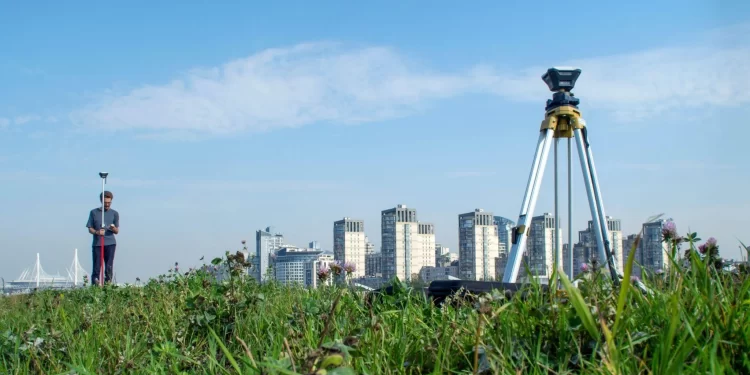If you find people swarming a building construction site without actual building work taking place, but no actual structures appear to have been put in place, chances are a setting out survey is taking place – an essential step in any building process that should not be avoided at any cost.
Setting out or staking out is the process of transferring the design of a proposed structure onto its intended location, to ensure accurate construction as it progresses.
Table of Contents
Methods of Setting Out
Setting out is the process of translating engineering plans and design drawings onto actual construction sites, to ensure their implementation meets intended specifications. This is performed by setting out engineers who are experts in their field. There are different techniques used in setting out surveys that may best suit different projects & terrain.
As the initial step, establish a set of control points on the ground – either as a baseline or grid – marked by physical markers such as pegs or batter boards with string lines or stakes.
The next step in site plan or drawing analysis is calculating each point’s location relative to its controlling points on the plan or drawing, creating what is known as “plines.”
Surveyors then use these “plines” to precisely locate features on construction sites – though in some instances survey CAD packages can even convert single features (blocks) into many points and strings at once!

GPS/GNSS Methods
Modern GPS/GNSS navigation technology has become an integral part of daily life, used by everyone from military personnel and farmers, aviators, and surveyors to civil engineers, farmers, and civilians alike. You can click the link: https://www.gps.gov/systems/gps/ for more information about GPS.
Private citizens also have access to portable GPS receivers. By employing this method of surveying, projects can be completed quickly if the accuracy specification and access requirements are carefully considered during planning. Nothing stops this method more quickly than locked gates, angry landowners, or government jurisdictions who believe they should have been involved earlier in the process.
Static GPS/GNSS surveys have long been used as an alternative method of surveying due to stumbling blocks that traditional surveyors faced. Unfortunately, however, this technique only offers redundancy if both ends of a baseline are simultaneously occupied to observe the same constellation of satellites – something often impossible in private land settings that require access by road or cannot be reached by helicopter.
Ground Penetrating Radar (GPR) Methods
GPR (ground penetrating radar) is an electromagnetic pulse survey technique that uses pulses of electromagnetic waves to explore subsurface areas without harming the environment or surface infrastructure. GPR can be used to locate reinforcement steel bars, electrical conduits, and water lines within concrete.
An ultrasound imaging method can also be used to map changes in subsurface materials, including voids, soil compaction, and layering. It is a non-invasive and less expensive alternative to traditional digging methods. You can visit this site to learn more.
GPR effectiveness depends heavily upon the material being surveyed, its electrical conductivity, and the antenna frequency used; generally speaking, higher frequencies offer better resolution but less penetration.
GPR signals are transmitted into the ground and then reflected towards a receiver antenna, recording their time of return, and thus providing depth data. Similar to any scanning method, penetration limits will depend on the physical properties of the material being scanned as one moves deeper underground more energy attenuation occurs.
Total Station Methods
Total stations are tools designed to measure angles and distances precisely. By applying trigonometry, these instruments can accurately compute the real positions of survey points.
Total stations use both electrical and optical scanning systems to measure distances between points. This information is then translated by a computer chip inside the instrument before being stored directly in its primary memory or downloaded onto a computer for final mapping.
Once the equipment is switched on, an operator will use its controller to make fine adjustments until the vertical axis of the theodolite lines up with its station mark exactly. Next, it is mounted onto a tripod with its centering screw tightened so centering can occur ensuring the total station is in the appropriate place for traverse as indicated by a message displayed on its field controller screen.
Setting out in surveying is an essential step in the process. There are several modern methods of accomplishing this task; these include GPS, GPR, and Total Station methods.


